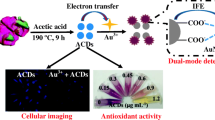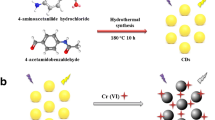Abstract
This study describes a new method for synthesizing water-soluble carbon dots (CDs) using “Curcuma longa” (green source) named CL-CDs via a single-step hydrothermal process. The as-synthesized CL-CDs exhibited greenish-yellow fluorescence at 548 nm upon excitation at 440 nm. It shows good water stability and exhibits a quantum yield of 19.4%. The developed probe is utilized for sensing triazophos (TZP) pesticide via a dynamic quenching mechanism, exhibiting favorable linearity ranging from 0.5–500 μM with a limit of detection of 0.0042 μM. The as-prepared CL-CDs probe was sensitive and selective towards TZP. Lastly, the successful application of the CL-CDs-based fluorescent probe in water and rice samples highlights its potential as a reliable and efficient method for the detection of TZP in various real sample matrices. Eventually, bioimaging and biocompatibility aspects of CL-CDs have been assessed on Saccharomyces cerevisiae (yeast) cell and lung cancer (A549) cell lines, respectively.








Similar content being viewed by others
Availability of Data and Materials
Data will be available from corresponding author on demand.
References
Lai W (2017) Pesticide use and health outcomes: Evidence from agricultural water pollution in China. J Environ Econ Manag 86:93–120
Patel H, Rawtani D, Agrawal YK (2019) A newly emerging trend of chitosan-based sensing platform for the organophosphate pesticide detection using Acetylcholinesterase-a review. Trends Food Sci Technol 85:78–91
Guo Y, Liu R, Liu Y, Xiang D, Liu Y, Gui W, Li M, Zhu G (2018) A non-competitive surface plasmon resonance immunosensor for rapid detection of triazophos residue in environmental and agricultural samples. Sci Total Environ 613:783–791
Guo YR, Liu SY, Gui WJ, Zhu GN (2009) Gold immunochromatographic assay for simultaneous detection of carbofuran and triazophos in water samples. Anal Biochem 389(1):32–39
Hong S, She Y, Cao X, Wang M, Zhang C, Zheng L, Wang S, Ma X, Shao H, Jin M, Jin F (2018) Biomimetic enzyme-linked immunoassay based on a molecularly imprinted 96-well plate for the determination of triazophos residues in real samples. RSC adv 8(37):20549–20556
Liang C, Jin R, Gui W, Zhu G (2007) Enzyme-linked immunosorbent assay based on a monoclonal antibody for the detection of the insecticide triazophos: assay optimization and application to environmental samples. Environ Sci Technol 41(19):6783–6788
Huang XC, Ma JK, Feng RX, Wei SL (2019) Simultaneous determination of five organophosphorus pesticide residues in different food samples by solid-phase microextraction fibers coupled with high-performance liquid chromatography. J Sci Food Agric 99(15):6998–7007
Wu L, Song Y, Hu M, Zhang H, Yu A, Yu C, Ma Q, Wang Z (2015) Application of magnetic solvent bar liquid-phase microextraction for determination of organophosphorus pesticides in fruit juice samples by gas chromatography-mass spectrometry. Food Chem 176:197–204
Yan M, Chen G, She Y, Ma J, Hong S, Shao Y, Abd El-Aty AM, Wang M, Wang S, Wang J (2019) Sensitive and simple competitive biomimetic nanozyme-linked immunosorbent assay for colorimetric and surface-enhanced raman scattering sensing of triazophos. J Agric Food Chem 67(34):9658–9666
Xie C, Zhou H, Gao S, Li H (2010) Molecular imprinting method for on-line enrichment and chemiluminescent detection of the organophosphate pesticide triazophos. Microchim Acta 171:355–362
Zhao Q, Song W, Zhao B, Yang B (2020) Spectroscopic studies of the optical properties of carbon dots: recent advances and future prospects. Mater Chem Front 4(2):472–488
Qu S, Wang X, Lu Q, Liu X, Wang L (2012) A biocompatible fluorescent ink based on water-soluble luminescent carbon nanodots. Angew Chem Int Ed 51(49):12215–12218
Atchudan R, Edison TNJI, Aseer KR, Perumal S, Karthik N, Lee YR (2018) Highly fluorescent nitrogen-doped carbon dots derived from Phyllanthus acidus utilized as a fluorescent probe for label-free selective detection of Fe3+ ions, live cell imaging and fluorescent ink. Biosens Bioelectron 99:303–311
Atchudan R, Edison TNJI, Perumal S, Muthuchamy N, Lee YR (2020) Hydrophilic nitrogen-doped carbon dots from biowaste using dwarf banana peel for environmental and biological applications. Fuel 275:117821
Muthamma K, Sunil D, Shetty P (2021) Carbon dots as emerging luminophores in security inks for anti-counterfeit applications-An up-to-date review. Appl Mater Today 23:101050
Ju J, Zhang R, He S, Chen W (2014) Nitrogen-doped graphene quantum dots-based fluorescent probe for the sensitive turn-on detection of glutathione and its cellular imaging. Rsc Adv 4(94):52583–52589
Vadia FY, Ghosh S, Mehta VN, Jha S, Malek NI, Park TJ, Kailasa SK (2023) Fluorescence “Turn OFF-ON” detection of Fe3+ and propiconazole pesticide using blue emissive carbon dots from lemon peel. Food Chem 136796
Wiggers HJ, Zaioncz S, Cheleski J, Mainardes RM, Khalil NM (2017) Curcumin, a multitarget phytochemical: challenges and perspectives. Stud Nat Prod Chem 53:243–276
Niranjan A, Prakash D (2008) Chemical constituents and biological activities of turmeric (Curcuma longa l.)-a review. J Food Sci Technol 45(2):109
Pal T, Mohiyuddin S, Packirisamy G (2018) Facile and green synthesis of multicolor fluorescence carbon dots from curcumin: in vitro and in vivo bioimaging and other applications. ACS Omega 3(1):831–843
Sadhu VA, Jha S, Park TJ, Kailasa SK (2023) Synthesis of copper nanoclusters from Bacopa monnieri leaves for fluorescence sensing of dichlorvos. Luminescence
Du D, Huang X, Cai J, Zhang A (2007) Amperometric detection of triazophos pesticide using acetylcholinesterase biosensor based on multiwall carbon nanotube-chitosan matrix. Sens Actuators B Chem 127(2):531–535
Li H, Xie C, Li S, Xu K (2012) Electropolymerized molecular imprinting on gold nanoparticle-carbon nanotube modified electrode for electrochemical detection of triazophos. Colloids Surf B 89:175–181
Ma S, He J, Guo M, Sun X, Zheng M, Wang Y (2018) Ultrasensitive colorimetric detection of triazophos based on the aggregation of silver nanoparticles. Colloids Surf A: Physicochem Eng 538:343–349
Bhamore JR, Ganguly P, Kailasa SK (2016) Molecular assembly of 3-mercaptopropinonic acid and guanidine acetic acid on silver nanoparticles for selective colorimetric detection of triazophos in water and food samples. Sens Actuators B Chem 233:486–495
Jawale RH, Gogate PR (2018) Combined treatment approaches based on ultrasound for removal of triazophos from wastewater. Ultrason Sonochem 40:89–96
Wang F, Hao Q, Zhang Y, Xu Y, Lei W (2016) Fluorescence quenchometric method for determination of ferric ion using boron-doped carbon dots. Microchim Acta 183:273–279
Acknowledgements
This work was financially supported by the Department of Science and Technology, Government of India under the Women Scientist Scheme-A(DST/WOS-A/CS-77/2021). FYV, NIM, and SKK sincerely acknowledge the Director, SVNIT, Surat, India, for providing the necessary infrastructure to carry out this work. This work was financially supported by Gujarat State Biotechnology Mission (GSBTM), DST, Govt. of Gujarat, India (BR-04 (GSBTM/JD(R&D)662/2022-23/00292169).
Funding
This work was financially supported by the Gujarat State Biotechnology Mission (GSBTM), DST, Govt. of Gujarat, India (BR-04 (GSBTM/JD(R&D)662/2022–23/00292169).
Author information
Authors and Affiliations
Contributions
All the authors are contributed to the study conception and design. FYV did the experiments and wrote the draft of manuscript. VNM characterized the synthesized probe. SJ performed cell imaging studies. TJP did XPS analysis. NIM did FT-IR analysis. SKK did conceptualization, supervision of the work.
Corresponding author
Ethics declarations
Ethical Approval
There are no ethical approvals required for this research work.
Consent for Publication
Not Applicable.
Competing Interests
The authors declare no competing interests.
Additional information
Publisher's Note
Springer Nature remains neutral with regard to jurisdictional claims in published maps and institutional affiliations.
Supplementary Information
Below is the link to the electronic supplementary material.
Rights and permissions
Springer Nature or its licensor (e.g. a society or other partner) holds exclusive rights to this article under a publishing agreement with the author(s) or other rightsholder(s); author self-archiving of the accepted manuscript version of this article is solely governed by the terms of such publishing agreement and applicable law.
About this article
Cite this article
Vadia, F.Y., Mehta, V.N., Jha, S. et al. Development of Simple Fluorescence Analytical Strategy for the Detection of Triazophos Using Greenish-Yellow Emissive Carbon Dots Derived from Curcuma longa. J Fluoresc (2023). https://doi.org/10.1007/s10895-023-03548-x
Received:
Accepted:
Published:
DOI: https://doi.org/10.1007/s10895-023-03548-x




